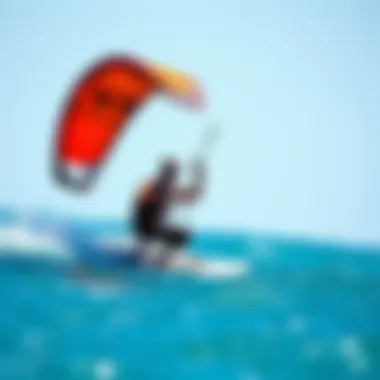Thermal Foil Technology in Kiteboarding: Insights and Impact


Intro
As kiteboarding continues to evolve, innovations such as thermal foil technology are making significant waves in the sport. Thermal foils offer an intriguing blend of engineering and artistry, enhancing not just the performance of the boards, but the overall experience for riders at every skill level. Understanding this technology is paramount for those invested in kiteboarding, whether you are an enthusiast, an instructor, or involved in organizing kiteboarding events.
To fully appreciate the impact of thermal foils, it’s crucial to explore various aspects that enhance rider experience. This entails not only studying gear selection and technical skill development, but also understanding the environmental influences and safety protocols necessary for optimal performance on the water. By navigating through these elements, we aim to create a comprehensive guide that educates and inspires members of the kiteboarding community.
In the following sections, we will delve deep into the nuances of gear selection — including types of kites and how to choose the right board for thermal foil advancements. Following that, we’ll tackle essential techniques and tips for skill progression, revealing how riders can maximize their capabilities with this innovative technology.
Equipping yourself with knowledge about these advancements ensures not only improved performance but also fosters safer and more sustainable practices that resonate with today’s environmental consciousness. Let’s take the plunge and gear up for this journey into the world of thermal foils and their implications in kiteboarding.
Prelims to Thermal Foil
Thermal foil technology has carved a niche in the adventurous world of kiteboarding, bringing with it a host of benefits and enhancements that have fundamentally changed the riding experience. This section aims to underline the significance of thermal foil, examining how its innovations push the boundaries of performance while considering crucial aspects, such as design choices and environmental implications.
Defining Thermal Foil
At its core, thermal foil refers to a specialized appendage attached to a kiteboard that utilizes principles of thermal dynamics to enhance lift and reduce drag. It operates primarily in conjunction with the kite, using the wind's thermal energy to produce lift, allowing riders to soar above the water with greater efficiency. This allows the rider not only to glide with less effort but also to reach unparalleled speeds, making it a must-have for serious kiteboarding enthusiasts.
Unlike traditional boards that rely purely on wind for propulsion, thermal foils harness various environmental factors. "You basically ride on the air, not just the water," one rider noted, highlighting how the technology elevates the sport to a whole other level. The geometry of a thermal foil is designed meticulously, ensuring maximum buoyancy and stability. Hence, understanding its operation and the immediate effects on performance is essential for both riders and instructors.
Historical Perspective
The roots of thermal foil technology in kiteboarding can be traced back to the early 2000s when experimentation began to take hold among pioneering riders. Initially, the concept was met with skepticism; many considered it a mere gimmick. Over time, however, the pragmatic and innovative approaches of enthusiastic kiteboarders led to significant advancements in foil design and functionality. Today, thermal foils have become synonymous with high-performance kiteboarding, creating new avenues for exploration in both competitive and recreational settings.
During its nascent stage, many proponents used makeshift materials to prototype their foils. Popularizing this innovative approach, riders like Robby Naish and others began to demonstrate the potentials of building these devices tailored to personal riding styles and conditions. Manufacturers soon capitalized on these developments, conducting extensive research to improve materials and manufacturing processes, further optimizing the technology.
As thermal foiling gains ground, it not only reshapes the way we perceive kiteboarding but also broadens its horizons, allowing enthusiasts to explore once-inaccessible areas by gliding gracefully.
This historical evolution reflects an essential aspect of kiteboarding: the influence of community and shared passion for innovation. By delving into the past achievements surrounding thermal foils, one gains a necessary appreciation for the complexity and ingenuity that characterized the modern-day kiteboarding environment.
Understanding the Technology
Understanding the technology behind thermal foils is essential for kiteboarders looking to enhance their riding experience. This section outlines the key elements of thermal foils, discussing the materials used, their manufacturing processes, and their relevance to performance in kiteboarding. By grasping these concepts, enthusiasts and professionals can make informed decisions and appreciate the intricate innovations that define modern kiteboarding.
Materials Used in Thermal Foils
The choice of materials when it comes to thermal foils plays a crucial role in their performance and durability. Kiteboarders are likely already aware of some standard components like fiberglass and carbon fiber, but the industry has seen advancements that go beyond these traditional materials.
- Carbon Fiber: Renowned for its light weight and exceptional strength, carbon fiber ranks high among the favorites for foil components. Its ability to provide responsive handling means riders can experience better control during their maneuvers.
- Aluminum Alloys: These materials often serve as frames due to their balance of weight and sturdiness. Aluminum can withstand the stress of sea conditions while keeping the overall weight low, which is vital for efficient riding.
- Plastic Composites: Some novices might overlook these but they do offer certain advantages. They are generally more affordable and can be molded into varying shapes. While they may not always match the performance of carbon fiber, they can still provide a great entry point for new kiteboarders.
Moreover, the integration of advanced thermal-resistant materials ensures that the foil maintains performance even under extreme conditions. Understanding how these materials contribute to the foil's efficacy is vital for any kiteboarder aiming to maximize their riding experience.
Manufacturing Processes
While the materials themselves are essential, the processes by which these foils are manufactured require equal consideration. Effective manufacturing holds the key to ensuring that the final product performs as intended in the water.
- Pre-preg Layup: This technique involves layering materials like carbon fiber with resin in a controlled environment. The application of heat during this stage helps bond the fibers to the resin effectively, creating a robust but lightweight structure.
- CNC Machining: Computer Numerical Control (CNC) machining is useful in shaping and creating intricate designs that can be replicated with precision. This process can lead to better aerodynamics in a kiteboard's performance, allowing riders to cut through the water more efficiently.
- Quality Inspection: Manufacturers often perform rigorous quality checks through non-destructive testing methods. This may seem mundane, but it's key to ensuring every foil can withstand the user’s demands across diverse riding conditions.
"A seamless blend of materials and expert manufacturing processes leads to innovations that not only enhance performance but also elevate the rider's overall experience on the water."
In summary, grasping the nuances of materials and manufacturing processes lays a solid foundation for understanding thermal foil technology. Given the complexity of the components and their interactions, kiteboarding enthusiasts should appreciate the thoughtful engineering behind these tools, reinforcing their choice for an optimal riding experience.
Performance Advantages


The essence of kiteboarding lies in its ability to seamlessly blend speed, agility, and control on the water. One of the groundbreaking elements ushering in this new era of efficiency in the sport is the development of thermal foils. In this section, we will delve into the performance advantages offered by these innovations, focusing on three key aspects: enhancing lift and speed, stability and control, and wind resistance features.
Enhancing Lift and Speed
Thermal foils are designed to maximize lift while minimizing drag, a combination that translates to higher speeds and better performance on the water. Understanding the physics behind lifts helps kiteboarders appreciate why these foils maneuver differently compared to traditional designs.
"The lift generated by a thermal foil increases exponentially with speed, allowing riders to ascend with less power, enabling longer sessions."
- Benefits of lift enhancement include:
- Efficient Glide: The aerodynamic shape of thermal foils fosters smooth transitions while gliding, reducing water resistance and improving overall speed.
- Increased Higher Speed Limits: Riders can achieve greater velocities without needing exceptional strength or skills.
- Ability for Quick Ascents: The design accommodates rapid ascents in underwhelming wind conditions, letting even novice kiteboarders catch more air.
Stability and Control
Stability is crucial in kiteboarding, especially at high speeds or during abrupt maneuvers. Thermal foils contribute significantly to the stability of the kite by lowering the center of gravity and distributing load effectively. This advantage makes a kiteboard less susceptible to gusts and turbulent water conditions.
- Key factors enhancing stability include:
- Balanced Load Distribution: The construction helps align the foil with the water surface, enhancing control without excessive rider input.
- Predictable Handling: Ride confidently in varying conditions, as thermal foils respond predictably, making them suitable for riders of all skill levels.
- Reduced Surface Area Interaction: By spending more time in the air rather than skimming the water, instability from choppy waves is mitigated.
Wind Resistance Features
In kiteboarding, the interaction of the wind and the performance of the foil is paramount. Thermal foils are crafted with advanced designs that optimize performance against wind resistance, allowing the rider to harness the wind's energy rather than fight against it.
- Important wind resistance features consist of:
- Optimized Aerodynamic Profiles: The shape of thermal foils cuts through the air smoothly, maintaining speed even in less-than-ideal wind conditions.
- Improved Lift-to-Drag Ratios: These foils achieve higher lift at lower angles of attack, reducing drag and improving efficiency during wind gusts.
- Enhanced Control in Crosswinds: The design reduces the foil's propensity to weave during strong winds, leading to smoother rides and a more enjoyable experience overall.
Thermal foils not only enhance performance in terms of speed and lift but also ensure stability and control, all while providing significant resistance to the elements. This blending of advantages paves the way for a more exhilarating kiteboarding experience, pushing the boundaries of what’s possible on the water.
Design Considerations
When it comes to kiteboarding, the effectiveness of thermal foils goes beyond raw performance; it encompasses many design elements that can significantly impact a rider's experience. The right design not only optimizes performance but also aligns with personal preference, safety, and environmental factors. A well-thought-out design can cater to varying conditions, rider skill levels, and aesthetic choices.
Shape and Size Variations
The shape and size of thermal foils play a crucial role in their function. Variations in these aspects can influence lift, drag, and overall stability.
- Shape: Different shapes, such as elliptical or triangular, can affect how a foil slices through water and responds to wind conditions. For instance, an elliptical shape might offer better lift at lower speeds, making it ideal for beginners still getting their sea legs. Conversely, a pointed shape can excel in high-speed scenarios, catering to advanced riders who seek agility.
- Size: The size of the thermal foil is linked closely with the rider's weight, skill level, and intended use. Larger foils typically generate more lift, suitable for heavier riders or those venturing into light wind conditions. However, smaller foils may facilitate better maneuverability and speed for more experienced kiteboarders, emphasizing the need for a thoughtful match between rider and equipment.
Understanding these intricacies helps kiteboarding enthusiasts make informed choices tailored to their specific needs and preferences.
Color and Aesthetic Choices
While the technical aspects of thermal foils take precedence in performance, the visual appeal shouldn’t be overlooked. Color and aesthetic choices can significantly influence a rider's connection with their gear.
- Visibility: Bright colors may not only stand out visually but also increase safety by making the foil more noticeable on the water, especially in busy or crowded settings.
- Personal Expression: Each rider has a unique personality and style. Custom designs are on the rise, from vibrant murals to subtle gradients, providing a platform for self-expression. This aspect fosters a deeper emotional connection, elevating the overall riding experience.
- Impact on Performance: Interestingly, the color can affect thermal absorption. Darker colors may retain heat, potentially influencing air bubbles in the water, thus impacting performance slightly. Although the effect is minimal, it still broadens the conversation about the interplay of design and function in kiteboarding.
Environmental Impact
Understanding the environmental impact of thermal foils in kiteboarding is essential for promoting sustainable practices within the sport. As kiteboarding enthusiasts, we thrive on the thrill of the wind and waves, yet it is crucial to acknowledge our responsibility toward the environment that nurtures this passion. The sustainable sourcing of materials, alongside the effects of water and wind on thermal efficiency, plays a pivotal role in how we approach kiteboarding today and in the future.
Sustainability in Material Sourcing


The materials used in the production of thermal foils carry significant weight in the conversation around environmental sustainability. Traditionally, many kiteboarding products were made from plastics and other non-biodegradable materials. However, innovations in sustainable material sourcing are changing that narrative. Many manufacturers are exploring alternative materials such as biodegradable resins and recycled fabrics, aiming to reduce the ecological footprint associated with production.
Adopting sustainable practices not only contributes to environmental preservation but also provides tangible benefits for kiteboarders. For instance, the use of eco-friendly materials often results in lighter and more durable products. This not only enhances performance on the water but also reduces the overall resource consumption during production. Such initiatives can also boost a brand’s reputation, capturing the attention of environmentally-conscious consumers.
"Choosing materials that are kind to the earth demonstrates a commitment not only to performance but to future generations of kiteboarders who will inherit this beautiful planet."
Some specific approaches to note include:
- Locally sourced raw materials: Reducing transport emissions while supporting local economies.
- Long-lasting designs: Crafting products that withstand wear and tear decreases the frequency of replacements.
- Recycling initiatives: Encouraging users to return end-of-life products for sustainable recycling.
Water and Wind Effects on Thermal Efficiency
Another crucial aspect of the environmental impact of thermal foils revolves around their interaction with water and wind—elements intrinsic to kiteboarding. The efficiency of a thermal foil can significantly influence energy consumption and performance in varying conditions. For example, a well-designed thermal foil reduces drag, allowing for smoother gliding over water, thus conserving energy and enhancing the kiteboarder's experience.
When considering thermal efficiency, one must take into account the following:
- Water temperature: Warm water can increase buoyancy and lift, affecting the energy dynamics during rides.
- Wind patterns: Optimizing designs to harness local wind conditions can enhance performance and minimize material waste.
Moreover, kiteboarding gear that performs efficiently in varied conditions helps to promote longer sessions out on the water with less reliance on artificial enhancements, such as motorboats or tow-in setups. This not only aligns with eco-friendly practices but also enriches the rider's connection to nature, fostering a deeper appreciation for our surroundings.
Safety Protocols
Safety protocols within the kiteboarding arena can't be emphasized enough. Navigating the winds with a thermal foil can be exhilarating but, like any adventure, it comes with its own set of risks. Whether you're a seasoned rider or a rookie just hitting the water, understanding these protocols guarantees not only your well-being but also enhances the overall kiteboarding experience.
Rider Experience and Skill Levels
When it comes to kiteboarding with a thermal foil, the correlation between skills, experience, and safety cannot be overlooked. Novice riders often underestimate the immense power of wind and water, leading to potential mishaps. Before even thinking about hitting those waves, it’s crucial for inexperienced riders to undergo comprehensive training sessions. This generally includes:
- Learning the Basics: Getting a grip on control, balance, and steering with the foil. Riders should understand how to adjust their weight and center of gravity effectively while racing across the water.
- Understanding the Gear: Riders must familiarize themselves with thermal foils and kiteboarding equipment. Knowledge of how each component functions significantly contributes to effective risk management. For instance, understanding which type of thermal foil suits your skill level can prevent accidents.
- Wind Conditions Awareness: Riders should also be well-acquainted with wind speed and direction. Not every wind condition is suitable for kiteboarding, especially when foils come into play. Navigating during gusty winds can lead to loss of control.
Moreover, it's advisable for advanced riders to assess their capabilities regularly. Just because someone could surf those waves last summer doesn’t mean conditions are the same today.
"Safety is not just a practice but a mindset. Always be aware of your surroundings and the capabilities of your gear."
Equipment Failure Prevention
A significant aspect of kiteboarding safety revolves around equipment maintenance and failure prevention. Not giving due attention to gear can turn a fantastic session into a dangerous ordeal quicker than you can say 'kite.' Key practices to follow include:
- Regular Inspections: Before heading out, it is essential to inspect your thermal foil for any signs of wear or damage. Areas to scrutinize include bladders, seams, and the lines. A minor tear can turn into a significant issue when you're moving at high speeds.
- Proper Storage: When not in use, store your equipment properly. Ensuring that your thermal foil is kept in a dry place and free from extreme temperatures prolongs its life and efficiency.
- Rider Equipment Preparation: Adequate preparation isn’t solely about the kites. Riders must have personal safety gear in place—helmets, impact vests, and proper foot straps are not optional. They provide added protection if things go sideways.
- Emergency Protocols: Riders should know emergency procedures, including how to self-land a kite in case of gear malfunction. Knowing the route back to shore is vital too, especially if equipment failure occurs far from a safe point.
Creating a safety-first culture in the kiteboarding community helps build a supportive environment. All champion riders started somewhere, and sharing insights for keeping safe can make the experience enjoyable for everyone involved.
For further information on kiteboarding safety practices, refer to Kiteboarding Safety Guidelines and insights from experts on National Association of Kiteboarding.
Maintenance Practices
When it comes to kiteboarding, the maintenance of your thermal foil is as crucial as the equipment itself. Proper maintenance not only extends the life of the gear but also ensures optimal performance during sessions on the water. Riders often overlook this aspect, thinking that if the foil looks fine, it works fine. However, neglecting maintenance can lead to unforeseen issues and diminished performance.
To optimize your kiteboarding experience, it's essential to adopt a routine for cleaning, storing, and assessing the wear of your thermal foil. The steps below highlight practical tips that can keep your gear in tip-top shape, allowing you to enjoy those thrilling moments on the water.
Cleaning and Storage Tips
Taking good care of your thermal foil begins with cleaning it. Saltwater, sand, and debris accumulate over time, which can lead to corrosion and performance issues. Here are some effective cleaning and storage tips:


- Rinse After Use: Always rinse your thermal foil with freshwater after each session. This simple step removes salt residue and prevents build-up.
- Use Mild Soap: If you find stubborn grime, use a mild soap and a soft cloth to wipe down your foil. Avoid any harsh chemicals that can degrade the material.
- Dry Thoroughly: After cleaning, dry the foil completely before storing it. Mold can become a problem if moisture is trapped.
- Storage Environment: When putting your gear away, store it in a cool, dry place. Extreme temperatures or direct sunlight can weaken the materials over time.
- Use a Protective Bag: Consider using a padded bag designed specifically for foils. This will protect it from physical damage during transportation and storage.
Following these steps will not only keep your thermal foil clean but also preserve its structural integrity.
Assessing Wear and Tear
Regularly checking your thermal foil for wear and tear is vital to ensure safety and performance. The last thing you want is equipment failure when you're riding high on waves. Here are some essential things to keep an eye on:
- Visual Inspections: Perform a visual inspection before each use. Look for any signs of cracks, warping, or scratches. These can all affect performance and indicate underlying issues.
- Check Connections: Make sure all connections are secure. Loose components can lead to unwanted movements and affect control.
- Blade Condition: Pay close attention to the condition of the blades. They should be smooth and free of any significant dents or nicks. A damaged blade can severely impact lift and speed.
- Foil Structure: Over time, the overall shape of the foil can change. If you notice a bend or twist, consult with a professional before hitting the water.
- Replacement Timeline: Be mindful of how often you use your foil. Most manufacturers recommend a routine replacement schedule. Be cautious—sometimes the damage isn't visible to the naked eye.
To encapsulate, routine maintenance practices are not merely recommendations but essential procedures for any kiteboarder keen on maximizing performance and safety. Paying close attention to your gear goes a long way in sustaining both your riding experience and the longevity of your equipment.
"A well-maintained thermal foil is the difference between gliding through waves and being caught in a storm."
Stay informed and proactive with your maintenance schedule, and you’ll reap the benefits while enjoying your time on the water.
For resources on kiteboarding, check out Wikipedia and Britannica for more information.
Market Trends and Future Innovations
The kiteboarding industry is perpetually evolving, and at the heart of this transformation is the introduction of innovative technologies. Understanding the market trends and future innovations surrounding thermal foil technology is crucial for kiteboarding enthusiasts, instructors, and event organizers. It informs the decisions that impact everything from gear selection to competitive strategies, ultimately enhancing rider experiences.
Emerging Technologies in Kiteboarding Gear
As kiteboarding continues to gain traction worldwide, several emerging technologies are shaping its future. Thermal foils are at the forefront of this evolution, intertwining with advancements such as:
- Smart Sensors: Devices integrated into kites that offer real-time data on wind speed and direction, allowing riders to adjust their techniques on the fly.
- 3D Printing: Customization of thermal foils becomes more accessible, giving riders tailored experiences that match their performance styles or even preferences for aesthetics.
- Lightweight Materials: Innovations in materials, like carbon fiber reinforced plastics, allow for stronger, yet lighter, foils that enhance speed without compromising stability.
These technologies not only enhance performance but also improve safety and ease of use, reducing the learning curve for newcomers.
Forecasting the Evolution of Thermal Foils
Looking ahead, the evolution of thermal foils in kiteboarding hinges on several key factors. Innovation in both design and functionality is expected to shift the dynamics of the sport. Here’s what might shape their future:
- Increased Energy Efficiency: Future thermal foils may harness wind energy more effectively, allowing riders to travel longer distances with less physical exertion.
- Integration of Eco-friendly Materials: As environmental consciousness rises, manufacturers may focus on using sustainable materials that do not compromise performance. Expect to see foils that leverage bioplastics or recyclable materials.
"The future lies in our ability to innovate responsibly, ensuring that kiteboarding remains a thrilling yet sustainable pastime."
- Enhanced Safety Features: Future foils may include built-in safety mechanisms that automatically adjust to sudden gusts or other changing conditions, providing added peace of mind.
In summary, as the market trends shift towards high-tech solutions and environmentally sustainable practices, the evolution of thermal foils will likely keep pace. It’s an exhilarating time for kiteboarding, where the blend of innovation and tradition promises a fascinating future ahead. By remaining informed about these emerging technologies and forecasting advancements, the kiteboarding community can better prepare for the changes that lie ahead, ensuring they stay at the forefront of this dynamic sport.
For further reading on these topics, you may explore resources like Wikipedia, Britannica, and discussions on platforms like Reddit or industry reports from Kiteboarding School Association.
The End
The discussion of thermal foil technology within kiteboarding presents a vital intersection of innovation and practical performance. In understanding this technology, kiteboarders can better appreciate how thermal foils enhance their riding experience, from increasing speed to ensuring greater stability on the water. Emphasizing the implications of these advancements not only sheds light on how they can elevate individual performance but also how they are shaping the kiteboarding community as a whole.
Summarizing Key Insights
As we break down the core insights derived from this exploration into thermal foils, it's clear that several key elements stand out:
- Performance Boost: Thermal foils provide enhanced lift and speed, allowing riders to navigate challenges with ease.
- Durability and Reliability: The materials and manufacturing processes employed enhance the longevity of the gear, reducing the chance for mid-session failures.
- Safety Considerations: Adopting proper safety protocols influenced by thermal foil technology ensures that all levels of riders can enjoy their sessions without compromising their well-being.
- Sustainability Focus: As discussed in previous sections, the sourcing of materials for thermal foils leans towards more environmentally friendly options, contributing to a more sustainable kiteboarding culture.
Final Thoughts on the Future of Kiteboarding
Looking toward the horizon, several trends shape the future of kiteboarding, particularly regarding thermal foils. With ongoing advancements in material science and design innovation, we can expect:
- More Adaptive Technology: Future advancements may bring more adaptive thermal foils, evolving with wind conditions for a more personalized riding experience.
- Increased Community Engagement: As technology becomes more accessible, there’s likely to be a shift towards community-led innovations—riders sharing their own customizations and modifications.
- Environmental Awareness: The emphasis on sustainable practices will not only enhance the industry’s reputation but also attract new enthusiasts who prioritize ecological concerns.
In essence, the evolution of thermal foils stands as a testament to the wider trends shaping kiteboarding today. As we embrace these innovations, the journey promises to be as exciting as the sport itself.















